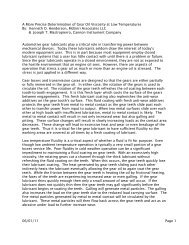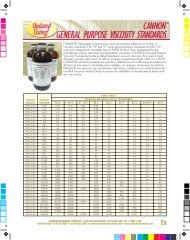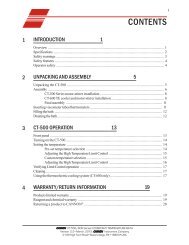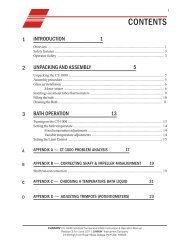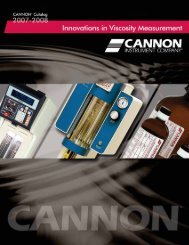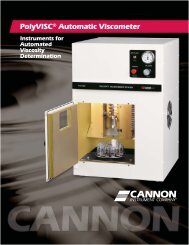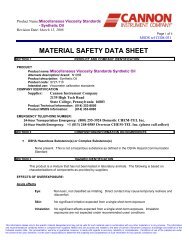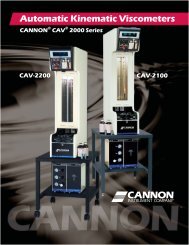significance of expanded uncertainty - Cannon Instrument Company
significance of expanded uncertainty - Cannon Instrument Company
significance of expanded uncertainty - Cannon Instrument Company
Create successful ePaper yourself
Turn your PDF publications into a flip-book with our unique Google optimized e-Paper software.
2<br />
5. If for particular applications, it is necessary to multiply the combined <strong>uncertainty</strong> by an overall <strong>uncertainty</strong>,<br />
the multiplying factor must always be stated.<br />
The Guide to the Expression <strong>of</strong> Uncertainty in Measurement (GUM)<br />
The above recommendation, INC-1 (1980), is a brief outline rather than a detailed prescription. Consequently,<br />
the CIPM asked the International Organization for Standardization (ISO) to develop a<br />
detailed guide based on the recommendation because ISO could more easily reflect the requirements<br />
stemming from the broad interests <strong>of</strong> industry and commerce. The ISO Technical Advisory Group on<br />
Metrology (TAG 4) was given this responsibility. It in turn established Working group 3 and assigned<br />
it to develop a guidance document based upon the recommendation <strong>of</strong> the BIPM Working Group on<br />
the Statement <strong>of</strong> Uncertainties which provides rules on the expression <strong>of</strong> measurement <strong>uncertainty</strong> for<br />
use within standardization, calibration, laboratory accreditation, and metrology services;<br />
The end result <strong>of</strong> the work <strong>of</strong> ISO/TAG 4/WG 3 was the 100-page Guide to the Expression <strong>of</strong> Uncertainty<br />
in Measurement (or GUM as it is now <strong>of</strong>ten called). It was published in 1993 (corrected and<br />
reprinted in 1995) by ISO in the name <strong>of</strong> the seven international organizations that supported its<br />
development in ISO/TAG 4:<br />
BIPM<br />
IEC<br />
IFCC<br />
ISO<br />
IUPAC<br />
IUPAP<br />
OIML<br />
Bureau International des Poids et Mesures<br />
International Electrotechnical Commission<br />
International Federation <strong>of</strong> Clinical Chemistry<br />
International Organization for Standardization<br />
International Union <strong>of</strong> Pure and Applied Chemistry<br />
International Union <strong>of</strong> Pure and Applied Physics<br />
International Organization <strong>of</strong> Legal Metrology<br />
GUM Acceptance<br />
GUM methods have been adopted by various regional metrology and related organizations including:<br />
NORAMET<br />
North American Collaboration in Measurement Standards<br />
NAVLAP<br />
National Voluntary Laboratory Accreditation Program<br />
A2LA<br />
American Association for Laboratory Accreditation<br />
EUROMET<br />
European Collaboration in Measurement Standards<br />
EUROLAB<br />
A focus for analytic chemistry in Europe<br />
EA<br />
European Cooperation for Accreditation<br />
EU European Union; adopted by CEN and published as EN 13005.<br />
The GUM has been adopted by NIST and most <strong>of</strong> NIST's sister national metrology institutes throughout<br />
the world, such as the National Research Council (NRC) in Canada, the National Physical Laboratory<br />
(NPL) in the United Kingdom, and the Physikalisch-Technische Bundesanstalt in Germany.<br />
The GUM is the standard reference used by CANNON <strong>Instrument</strong> <strong>Company</strong> in the determination <strong>of</strong><br />
uncertainties associated with our equipment and calibration procedures.<br />
Determination <strong>of</strong> Uncertainties<br />
Type A Uncertainty (variance that is capable <strong>of</strong> measurement by statistical means) determination may be<br />
made by any valid statistical method for treating data. Examples are calculating the standard deviation<br />
<strong>of</strong> the mean <strong>of</strong> a series <strong>of</strong> independent observations using the method <strong>of</strong> least squares to fit a curve to<br />
data in order to estimate the parameters <strong>of</strong> the curve and their standard deviations; and carrying out an<br />
analysis <strong>of</strong> variance (ANOVA) in order to identify and quantify random effects in certain kinds <strong>of</strong><br />
measurements.<br />
Type B Uncertainty (variance that is determined by other means) may include use <strong>of</strong> previous measurement<br />
data, general knowledge <strong>of</strong> relevant materials or instruments, manufacturer's specifications, and<br />
data provided in calibration and other reports.<br />
CANNON ® <strong>Instrument</strong> <strong>Company</strong><br />
2139 High Tech Road • State College, PA 16803- • USA<br />
PHONE: 814-353-8000 • FAX: 814-353-8007 • WEB: www.cannoninstrument.com



